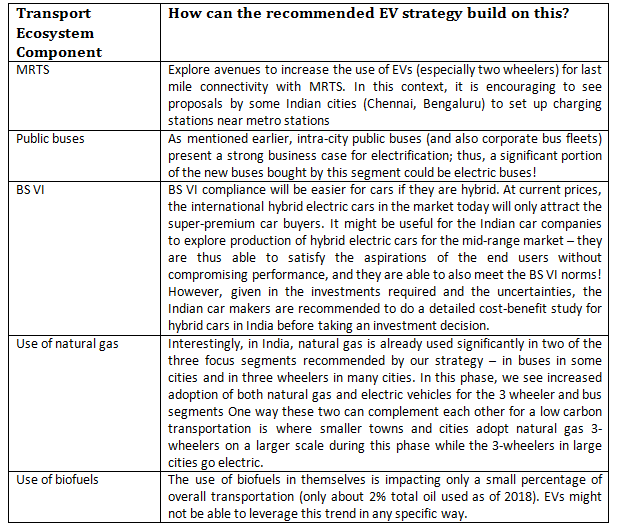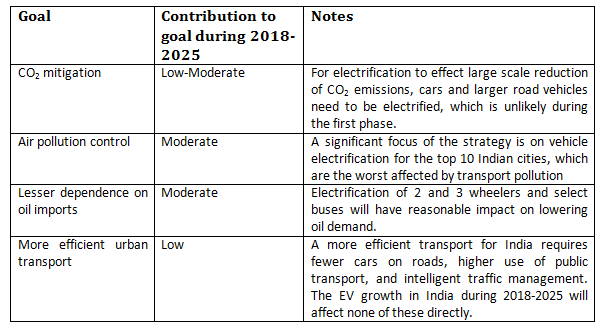Last Updated: February 2020 by Narasimhan Santhanam
This pos![]() t is a part of EV Next’s EV Perspectives.
t is a part of EV Next’s EV Perspectives.
EV Next, a division of EAI, is a leading market intelligence & strategic consulting firm for the Indian e-mobility sector.
Get to know about 1000+ EV innovations from EVI2: EV Innovation Intelligence from EVNext
An overview of trends in two related ecosystems for EVs i,e the Transport and Energy Ecosystems are provided in this post.
The growth of EVs should not be seen in isolation. The recommended growth strategy will be even more effective if it is able to build upon these trends. Let’s review how the strategy we have suggested can do that.
Suggestions on how the recommended strategy can build on the other transport and energy ecosystem trends
- Tie-ups with E-commerce Firms – Tie-ups with e-commerce firms having their own hyperlocal logistics network (eg: Swiggy) can be attempted, as most of such logistics are carried out using two-wheelers. This being an organized sector, suitable private charging stations could also be constructed to build a complete ecosystem.
- Tie-ups with Cab Hailing Services – Tie-ups can be attempted to have electric vehicles in their fleet. While there’s potential in this model, the challenges with using electric cars in India during this phase apply to this segment as well – in fact, this was attempted by Mahindra Electric with Ola Cabs recently, but did not do well. However, during this phase, rather than trying to go “All Electric”, Ola or Uber could offer a premium “green cabs” service as part of their solution, which caters to a small niche in their user-base. While this is likely to remain a small niche over the next few years, this could be a good start.
- Rooftop Solar + EV Charging Stations – From among the Energy Ecosystem trends, leveraging distributed solar power is perhaps the most effective model that can be tried in the short term. While rooftop spaces at city-based charging stations might not be enough to provide all the energy required, these will be a good start during this phase. The learning from these can be utilized while trying to integrate larger rooftop/on-premises solar power plants with charging stations outside city limits in the next phase.
How effective will the recommended strategy for achieving sustainable transportation goals?
How well does the recommended EV growth strategy contribute towards these goals during the 2018-2025 phase?
The recommended strategy, it can be seen, makes only a limited contribution to achieving the overall goals in sustainable transportation during the 2018-2025 phase. At the same time, a good start would have been made, and this can be used as a springboard for much higher contribution from EVs towards sustainable transportation post-2025.
Know more on how EV Next can assist your business in your strategy for the e-mobility and electric vehicles sectors, Here
Wish to know everything about India’s EV market from one place? Check out the India EV Expert Guide, an 800 page comprehensive guide to the Indian EV market. Here
Get to know about 1000+ EV innovations from EVI2: EV Innovation Intelligence from EVNext
See also the blog posts:
- Current and Expected Market Sizes of Electric Vehicles in India – E-scooter, Electric Car, Electric Rickshaws, E-bikes
- Key Indian Battery Makers Plans for EVs – Exide, Amara Raja, HBL, Eveready Strategy for Electric Vehicle Batteries
- Current and Future Market Sizes of Electric Vehicles – Global EV Growth
Comprehensive Inputs on Indian EV Ecosystem
Check out the following sections for comprehensive inputs on Indian EV ecosystem (click on each section for more details)





 Our specialty focus areas include
Our specialty focus areas include 


 ZEV India Partnership – Driving Truck Electrification through Collaboration
ZEV India Partnership – Driving Truck Electrification through Collaboration


